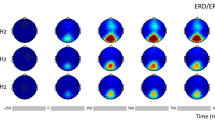Summary.
We studied 11 patients (7–15 years of age) with benign rolandic epilepsy of childhood. Spontaneous EEG and flash evoked potentials were recorded from 19 channels. Following visual stimulation, five of the patients displayed a late sustained component over temporal and central scalp regions (mean latency: 194.8 ms). The occurrence of this component was related to the spectra of spontaneous EEG and clinical parameters. Significant topographical differences were observed between the EEG amplitude spectra of patients with and without a N200 component. The effects were most evident in the lower alpha (7.5–9.5 Hz) and beta band (13–15 Hz) when temporal, parietal and occipital regions of the left and right hemisphere were compared. There was also a tendency that children without N200 displayed more hypersynchroneous activity in the spontaneous EEG than children with N200. This suggests a protective role of focal interictal spikes, and probably coincides with a benign prognosis of epilepsy.
Similar content being viewed by others
Author information
Authors and Affiliations
Rights and permissions
About this article
Cite this article
Skrandies, W., Dralle, D. Topography of spectral EEG and late VEP components in patients with Benign Rolandic Epilepsy of Childhood. J Neural Transm 111, 223–230 (2004). https://doi.org/10.1007/s00702-003-0093-8
Received:
Accepted:
Published:
Issue Date:
DOI: https://doi.org/10.1007/s00702-003-0093-8




